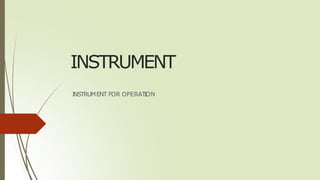
INSTRUMENTATION (1).pdf
- 2. What are the four parameter ? Pressure Level Flow Temperature
- 3. pressure What is pressure? 🠶 T he force acting unit area. 🠶 How calculate the pressure? 𝐹 🠶 P= 𝐴 𝑁 = = = Pa 𝑀2 🠶 Example : if the f=50n & A=2.5𝑚2 find the p=?
- 4. pressure 🠶 Units of pressure 🠶 Kpa 🠶 KG/CM2 🠶 BAR 🠶 PSI ( pound per square inch) 🠶 mmH2O 🠶 mmHg 🠶 inH2O 🠶 inHg 🠶 Use the convert table
- 5. pressure Units kPa Pa Bar Std. Atm. psi Kg/cm² mmH2O mmHg inHg inH20 kPa =1= 1000 0.01 0.0098692 0.145 0.0101972 101.9716 7.50062 0.2953 4.0146 Pa 0.001 =1= 0.00001 0.0000098 0.000145 0.0000101 97 0.1019716 0.007501 0.0002953 0.0040146 Bar 100 100,000 =1= 0.98692 14.5 1,019716 10,197.16 750.062 29.53 401.46 Std. Atm . 101.325 101,325 1.01325 =1= 14.696 1.033228 10,332.28 760 29.92 406.78 psi 6.89476 6,894.76 0.06895 0.068046 =1= 0.070307 703.072 51.715 2.036 27.68 Kg/cm² 98.0665 98,066.5 0.980665 0.967841 14.22 =1= 10,000 735.559 28.96 393.70 mmH20 0.0098067 9.80665 0.0000981 0.0000967 0.001422 0.0001 =1= 0.0735559 0.002896 0.03937 mmHg 0.1333224 133.3224 0.0013332 0.0013158 0.0193 0.0013595 13.5951 =1= 0.03937 0.53524 inHg 3.3864 3,3864 0.033864 0.03342 0.491 0.03453 345.3155 25.4 =1= 13.5951 inH2O 0.24909 249.09 0.002491 0.00246 0.0361 0.00254 25.4 1.8683 0.0735559 =1=
- 6. pressure 🠶 Type of pressure 🠶 Atmospheric pressure 🠶 Absolute pressure 🠶 Vacuum pressure 🠶 Pressure Gauge 🠶 Differential pressure
- 7. pressure 🠶 To calculate absolute pressure 🠶 Abs =Atm +Pg when Pg < 14.7 psi 🠶 Abs =Atm - Pg when Pg > 14.7 psi
- 8. pressure 🠶 Sensor & Device 🠶 Manometer 🠶 Pressure gauge 🠶 Differential pressuretransmitter
- 10. pressure 🠶 Digital Pressure gauge
- 12. Pressure 🠶 Differential pressure transmitter
- 13. FLOW 🠶 What is flow? 🠶 T he amount of liquid passes through a system 🠶 How calculate the flow? 🠶 Q= V *A 🠶 Where flow rate (Q) =flow velocity (V) ×pipe area (A) 🠶 Q=K* ℎ
- 14. FLOW 🠶 Units of flow 🠶 Liter/min 🠶 m3/hr 🠶 cut/sec 🠶 Kg/sec 🠶 tans/hr 🠶 gallon/min
- 15. FLOW 🠶 FlowMeasurement 🠶 a- Primary element 🠶 b- Secondary
- 16. FLOW 🠶 a- Primary element 🠶 Venturi 🠶 Orifice 🠶 Flownozzle
- 17. FLOW 🠶 Venturi: 🠶 The Venture tube has particular advantages: 🠶 Efficiency –they have very low pressurelosses 🠶 High accuracy 🠶 Suitability for fluids with suspended solids 🠶 The disadvantages of the Venture tube are: 🠶 Cost 🠶 S ize ( length ) 🠶 Difficulty of installation
- 18. FLOW 🠶 Orifice: The most common element used to create a differential pressure is the orifice plate 🠶 The Orifice Plate has particularadvantages: 🠶 Low cost 🠶 Small size 🠶 Essay of installation 🠶 The disadvantages of the Orifice Plate are: 🠶 Low pressure
- 19. FLOW 🠶 Flow nozzle: The flow nozzle ismore rigid than an orifice plate and will not deform at high temperatures and flow rates. 🠶 The advantages are: 🠶 Inexpensive 🠶 Easily manufactured 🠶 S imple to install or change because they fit between flanges 🠶 The disadvantages are: 🠶 Unsuitable for flows with suspended solids 🠶 Not as accurate as Venturi tubes 🠶 Have higher pressurelossesthan Venturi tubes
- 20. FLOW 🠶 b- Secondary 🠶 U-tube monometer 🠶 Differential pressure
- 21. FLOW 🠶 Flow devices: 🠶 Rota mater
- 22. FLOW 🠶 Flow devices: 🠶 Ultrasonic flowmete
- 23. FLOW 🠶 Flow devices: 🠶 Turbine flowmeter
- 24. FLOW 🠶 Flowdevices: 🠶 magnetic flow meter
- 25. LEVEL 🠶 What is the level? 🠶 Height of the liquid is called level 🠶 How calculate the level? 🠶 h = ∆𝑷 𝝆𝒈 h=high of liquid & ∆𝑷=pressure & 𝝆 =Densityof liquid g =Gravity
- 26. LEVEL 🠶 Units of level 🠶 mm 🠶 Cm 🠶 Feet 🠶 meter
- 27. LEVEL 🠶 Level types: 🠶 Liquid 🠶 Solid 🠶 Level measurement: 🠶 1-Direct method 🠶 2-indirect method
- 28. LEVEL 🠶 1-Direct method A-Dip stick
- 29. LEVEL 🠶 B-Gauge glasses 🠶Type 1-Tubular glass. 🠶Usingin the low pressure 🠶Easy maintenance 🠶Easy to broken 🠶Open tank 🠶Closed tank 🠶No severeoperation
- 30. LEVEL 🠶 Type 2-Reflex gauge glass. 🠶 Usingin the high pressure 🠶 Usuallyattached with light 🠶 Closedtank 🠶 Severe operation
- 31. LEVEL 🠶 C-Floats
- 33. LEVEL 🠶 B- Ultra sonic
- 36. TEMPERATURE 🠶 What is the Temperature? 🠶 Itis measurement of hotness or coldness 🠶 Unit of Temperature: 🠶 1-Celsius scale Ex:F=63.5 C=? 🠶 2-Kelvin scale Ex:C=32 K=? 🠶 3-The Fahrenheit scale Ex:C=17.5 F=? 🠶 4-Rankine Ex:F=120 R=? (C={F-32}/1.8) C=(63.5-32 )/1.8 =17.5 C (K=C+273) K=32+273=305K (F=1.8* C { + 32}) F=(1.8* 17.5)+32=63.5F (R=F+460) R=120+460=580R
- 37. TEMPERATURE 🠶 TEMPERATURE Device: 🠶 1-Glass thermometers
- 39. TEMPERATURE 🠶 3-Filled system thermometer
- 40. TEMPERATURE 🠶 4-Thermocouple Thermometer 🠶 Type: 🠶 A-Copper-Constantan 🠶 B-Iron- Constantan 🠶 C-Nickel-Nickel chromium 🠶 D-Chrome- Aluminum 🠶 E-Platinum- Platinum Rhodium type T type J type E type K types R-S
- 41. TEMPERATURE 🠶 5-Electrical resistance thermometer
- 42. Thank you